Compare and Contrast Any Two of the Schools of Strategy Formulation
VerifiedAdded on 2022/09/07
|10
|2871
|17
AI Summary
Contribute Materials
Your contribution can guide someone’s learning journey. Share your
documents today.
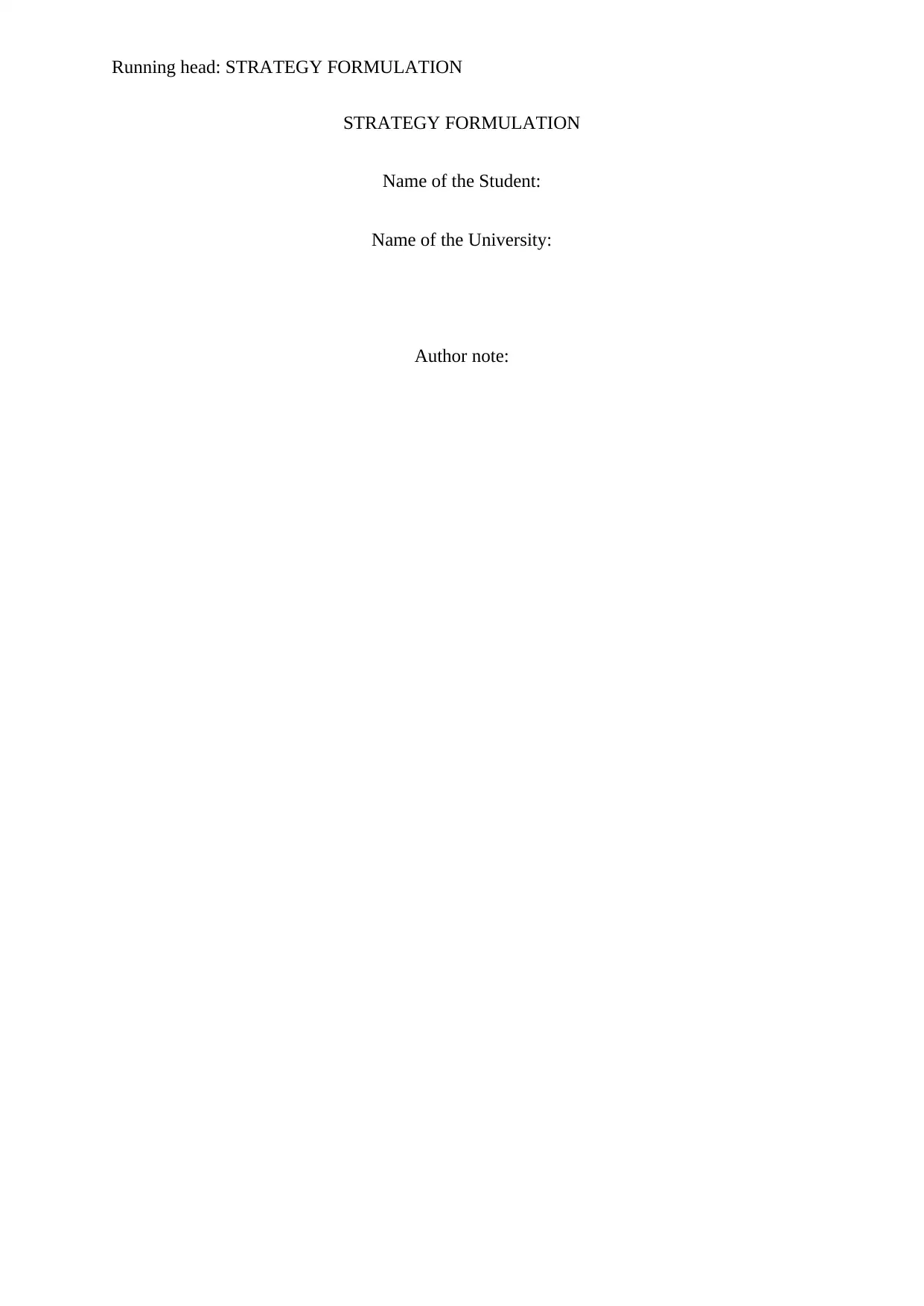
Running head: STRATEGY FORMULATION
STRATEGY FORMULATION
Name of the Student:
Name of the University:
Author note:
STRATEGY FORMULATION
Name of the Student:
Name of the University:
Author note:
Secure Best Marks with AI Grader
Need help grading? Try our AI Grader for instant feedback on your assignments.
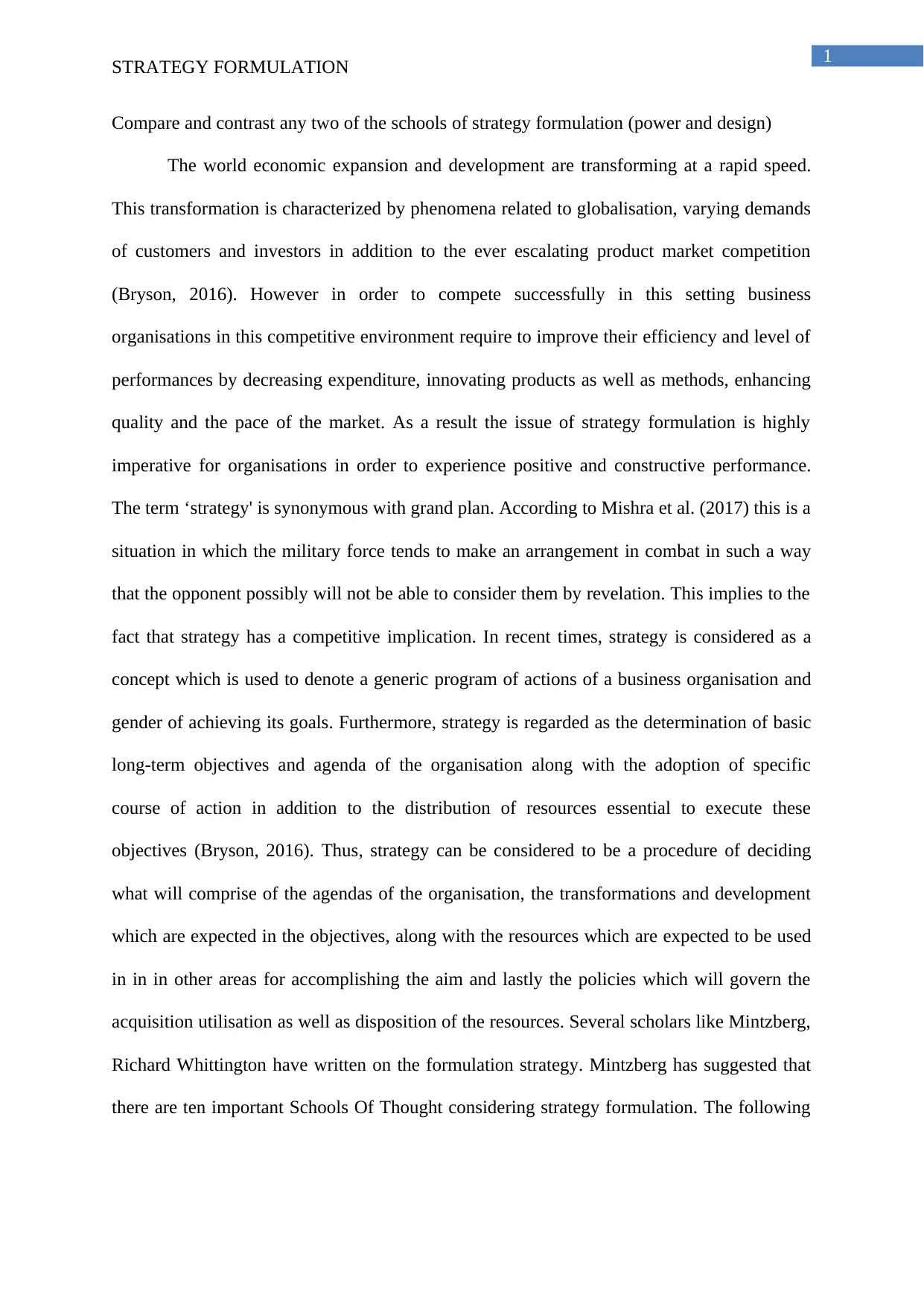
1
STRATEGY FORMULATION
Compare and contrast any two of the schools of strategy formulation (power and design)
The world economic expansion and development are transforming at a rapid speed.
This transformation is characterized by phenomena related to globalisation, varying demands
of customers and investors in addition to the ever escalating product market competition
(Bryson, 2016). However in order to compete successfully in this setting business
organisations in this competitive environment require to improve their efficiency and level of
performances by decreasing expenditure, innovating products as well as methods, enhancing
quality and the pace of the market. As a result the issue of strategy formulation is highly
imperative for organisations in order to experience positive and constructive performance.
The term ‘strategy' is synonymous with grand plan. According to Mishra et al. (2017) this is a
situation in which the military force tends to make an arrangement in combat in such a way
that the opponent possibly will not be able to consider them by revelation. This implies to the
fact that strategy has a competitive implication. In recent times, strategy is considered as a
concept which is used to denote a generic program of actions of a business organisation and
gender of achieving its goals. Furthermore, strategy is regarded as the determination of basic
long-term objectives and agenda of the organisation along with the adoption of specific
course of action in addition to the distribution of resources essential to execute these
objectives (Bryson, 2016). Thus, strategy can be considered to be a procedure of deciding
what will comprise of the agendas of the organisation, the transformations and development
which are expected in the objectives, along with the resources which are expected to be used
in in in other areas for accomplishing the aim and lastly the policies which will govern the
acquisition utilisation as well as disposition of the resources. Several scholars like Mintzberg,
Richard Whittington have written on the formulation strategy. Mintzberg has suggested that
there are ten important Schools Of Thought considering strategy formulation. The following
STRATEGY FORMULATION
Compare and contrast any two of the schools of strategy formulation (power and design)
The world economic expansion and development are transforming at a rapid speed.
This transformation is characterized by phenomena related to globalisation, varying demands
of customers and investors in addition to the ever escalating product market competition
(Bryson, 2016). However in order to compete successfully in this setting business
organisations in this competitive environment require to improve their efficiency and level of
performances by decreasing expenditure, innovating products as well as methods, enhancing
quality and the pace of the market. As a result the issue of strategy formulation is highly
imperative for organisations in order to experience positive and constructive performance.
The term ‘strategy' is synonymous with grand plan. According to Mishra et al. (2017) this is a
situation in which the military force tends to make an arrangement in combat in such a way
that the opponent possibly will not be able to consider them by revelation. This implies to the
fact that strategy has a competitive implication. In recent times, strategy is considered as a
concept which is used to denote a generic program of actions of a business organisation and
gender of achieving its goals. Furthermore, strategy is regarded as the determination of basic
long-term objectives and agenda of the organisation along with the adoption of specific
course of action in addition to the distribution of resources essential to execute these
objectives (Bryson, 2016). Thus, strategy can be considered to be a procedure of deciding
what will comprise of the agendas of the organisation, the transformations and development
which are expected in the objectives, along with the resources which are expected to be used
in in in other areas for accomplishing the aim and lastly the policies which will govern the
acquisition utilisation as well as disposition of the resources. Several scholars like Mintzberg,
Richard Whittington have written on the formulation strategy. Mintzberg has suggested that
there are ten important Schools Of Thought considering strategy formulation. The following
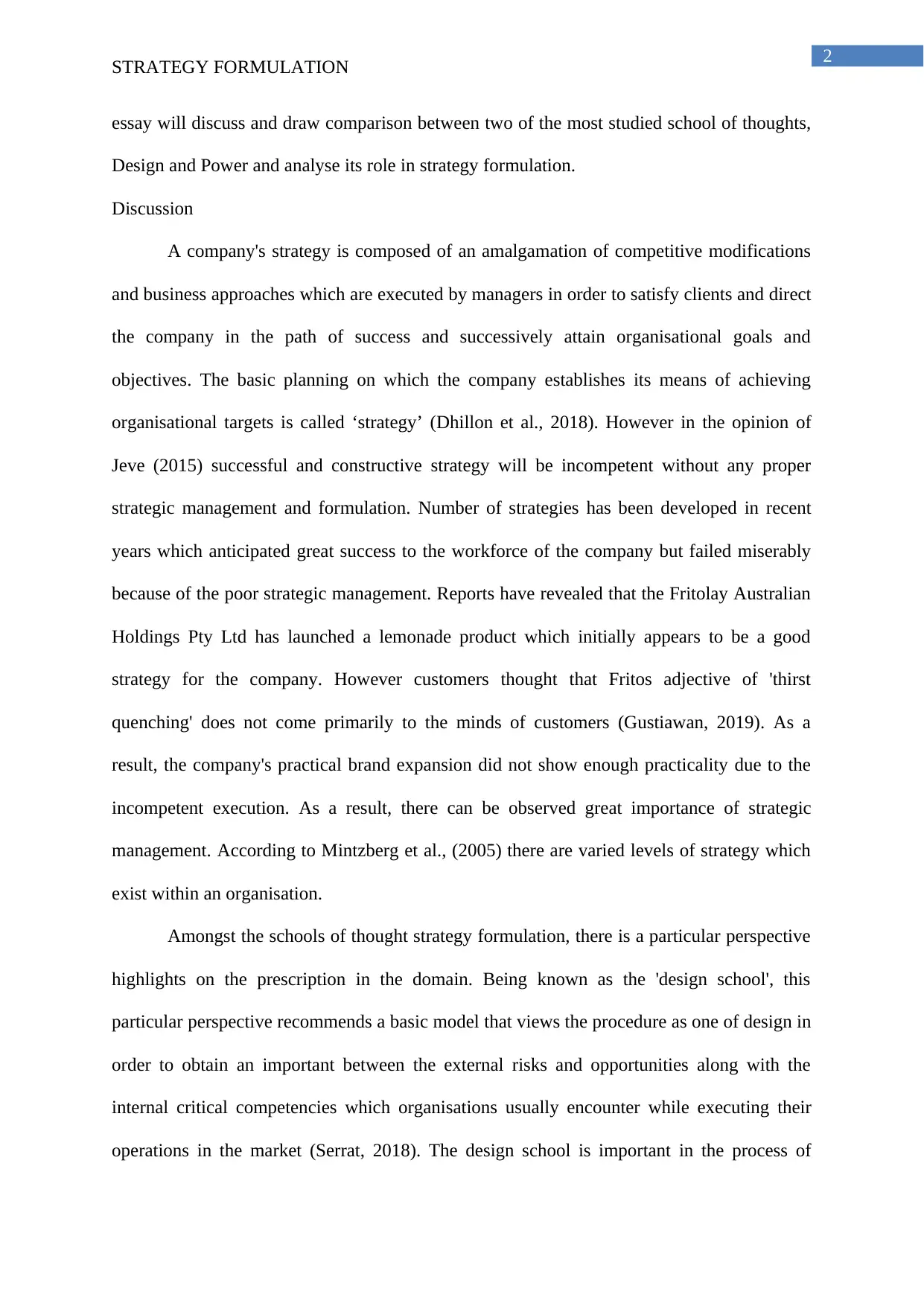
2
STRATEGY FORMULATION
essay will discuss and draw comparison between two of the most studied school of thoughts,
Design and Power and analyse its role in strategy formulation.
Discussion
A company's strategy is composed of an amalgamation of competitive modifications
and business approaches which are executed by managers in order to satisfy clients and direct
the company in the path of success and successively attain organisational goals and
objectives. The basic planning on which the company establishes its means of achieving
organisational targets is called ‘strategy’ (Dhillon et al., 2018). However in the opinion of
Jeve (2015) successful and constructive strategy will be incompetent without any proper
strategic management and formulation. Number of strategies has been developed in recent
years which anticipated great success to the workforce of the company but failed miserably
because of the poor strategic management. Reports have revealed that the Fritolay Australian
Holdings Pty Ltd has launched a lemonade product which initially appears to be a good
strategy for the company. However customers thought that Fritos adjective of 'thirst
quenching' does not come primarily to the minds of customers (Gustiawan, 2019). As a
result, the company's practical brand expansion did not show enough practicality due to the
incompetent execution. As a result, there can be observed great importance of strategic
management. According to Mintzberg et al., (2005) there are varied levels of strategy which
exist within an organisation.
Amongst the schools of thought strategy formulation, there is a particular perspective
highlights on the prescription in the domain. Being known as the 'design school', this
particular perspective recommends a basic model that views the procedure as one of design in
order to obtain an important between the external risks and opportunities along with the
internal critical competencies which organisations usually encounter while executing their
operations in the market (Serrat, 2018). The design school is important in the process of
STRATEGY FORMULATION
essay will discuss and draw comparison between two of the most studied school of thoughts,
Design and Power and analyse its role in strategy formulation.
Discussion
A company's strategy is composed of an amalgamation of competitive modifications
and business approaches which are executed by managers in order to satisfy clients and direct
the company in the path of success and successively attain organisational goals and
objectives. The basic planning on which the company establishes its means of achieving
organisational targets is called ‘strategy’ (Dhillon et al., 2018). However in the opinion of
Jeve (2015) successful and constructive strategy will be incompetent without any proper
strategic management and formulation. Number of strategies has been developed in recent
years which anticipated great success to the workforce of the company but failed miserably
because of the poor strategic management. Reports have revealed that the Fritolay Australian
Holdings Pty Ltd has launched a lemonade product which initially appears to be a good
strategy for the company. However customers thought that Fritos adjective of 'thirst
quenching' does not come primarily to the minds of customers (Gustiawan, 2019). As a
result, the company's practical brand expansion did not show enough practicality due to the
incompetent execution. As a result, there can be observed great importance of strategic
management. According to Mintzberg et al., (2005) there are varied levels of strategy which
exist within an organisation.
Amongst the schools of thought strategy formulation, there is a particular perspective
highlights on the prescription in the domain. Being known as the 'design school', this
particular perspective recommends a basic model that views the procedure as one of design in
order to obtain an important between the external risks and opportunities along with the
internal critical competencies which organisations usually encounter while executing their
operations in the market (Serrat, 2018). The design school is important in the process of
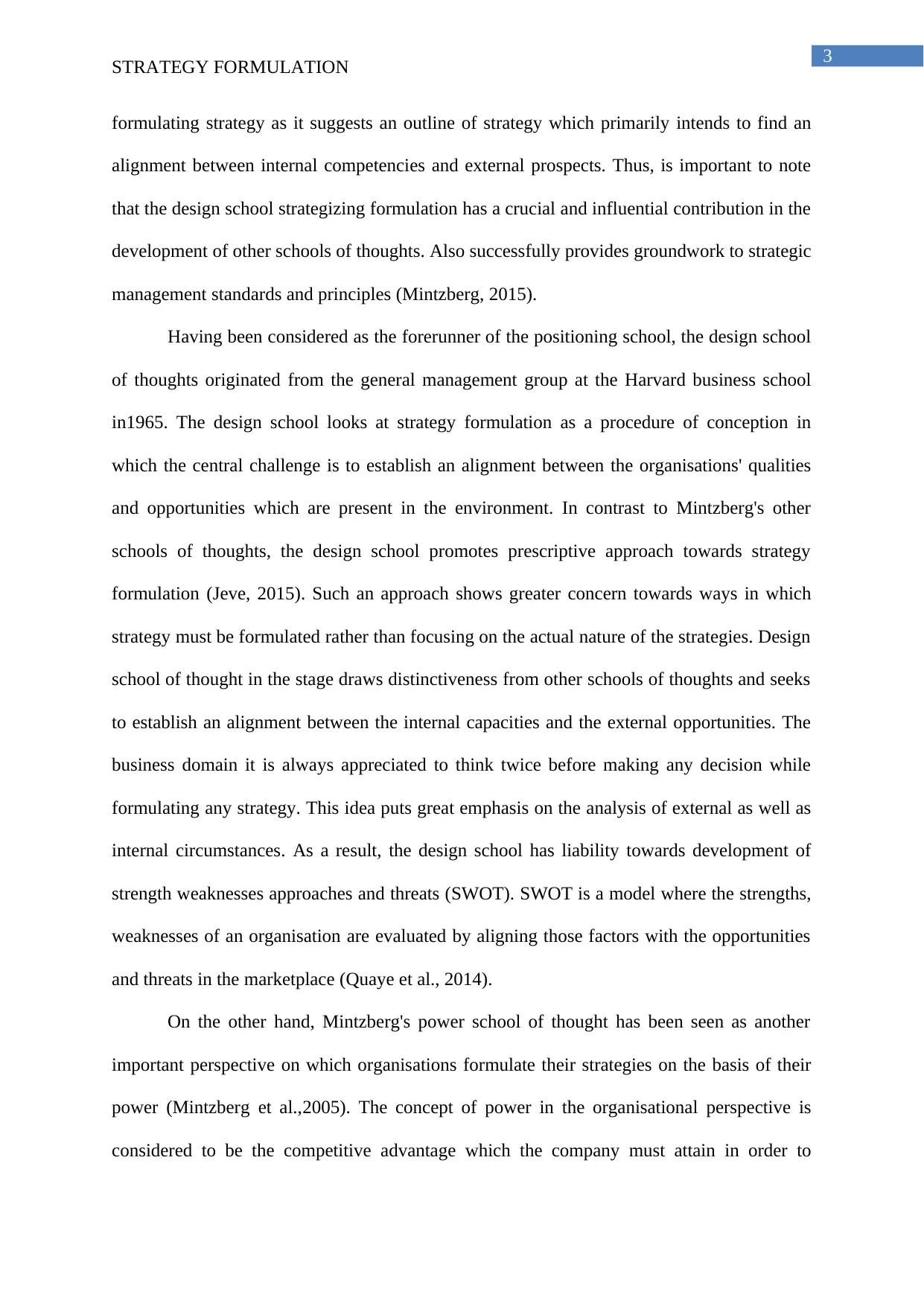
3
STRATEGY FORMULATION
formulating strategy as it suggests an outline of strategy which primarily intends to find an
alignment between internal competencies and external prospects. Thus, is important to note
that the design school strategizing formulation has a crucial and influential contribution in the
development of other schools of thoughts. Also successfully provides groundwork to strategic
management standards and principles (Mintzberg, 2015).
Having been considered as the forerunner of the positioning school, the design school
of thoughts originated from the general management group at the Harvard business school
in1965. The design school looks at strategy formulation as a procedure of conception in
which the central challenge is to establish an alignment between the organisations' qualities
and opportunities which are present in the environment. In contrast to Mintzberg's other
schools of thoughts, the design school promotes prescriptive approach towards strategy
formulation (Jeve, 2015). Such an approach shows greater concern towards ways in which
strategy must be formulated rather than focusing on the actual nature of the strategies. Design
school of thought in the stage draws distinctiveness from other schools of thoughts and seeks
to establish an alignment between the internal capacities and the external opportunities. The
business domain it is always appreciated to think twice before making any decision while
formulating any strategy. This idea puts great emphasis on the analysis of external as well as
internal circumstances. As a result, the design school has liability towards development of
strength weaknesses approaches and threats (SWOT). SWOT is a model where the strengths,
weaknesses of an organisation are evaluated by aligning those factors with the opportunities
and threats in the marketplace (Quaye et al., 2014).
On the other hand, Mintzberg's power school of thought has been seen as another
important perspective on which organisations formulate their strategies on the basis of their
power (Mintzberg et al.,2005). The concept of power in the organisational perspective is
considered to be the competitive advantage which the company must attain in order to
STRATEGY FORMULATION
formulating strategy as it suggests an outline of strategy which primarily intends to find an
alignment between internal competencies and external prospects. Thus, is important to note
that the design school strategizing formulation has a crucial and influential contribution in the
development of other schools of thoughts. Also successfully provides groundwork to strategic
management standards and principles (Mintzberg, 2015).
Having been considered as the forerunner of the positioning school, the design school
of thoughts originated from the general management group at the Harvard business school
in1965. The design school looks at strategy formulation as a procedure of conception in
which the central challenge is to establish an alignment between the organisations' qualities
and opportunities which are present in the environment. In contrast to Mintzberg's other
schools of thoughts, the design school promotes prescriptive approach towards strategy
formulation (Jeve, 2015). Such an approach shows greater concern towards ways in which
strategy must be formulated rather than focusing on the actual nature of the strategies. Design
school of thought in the stage draws distinctiveness from other schools of thoughts and seeks
to establish an alignment between the internal capacities and the external opportunities. The
business domain it is always appreciated to think twice before making any decision while
formulating any strategy. This idea puts great emphasis on the analysis of external as well as
internal circumstances. As a result, the design school has liability towards development of
strength weaknesses approaches and threats (SWOT). SWOT is a model where the strengths,
weaknesses of an organisation are evaluated by aligning those factors with the opportunities
and threats in the marketplace (Quaye et al., 2014).
On the other hand, Mintzberg's power school of thought has been seen as another
important perspective on which organisations formulate their strategies on the basis of their
power (Mintzberg et al.,2005). The concept of power in the organisational perspective is
considered to be the competitive advantage which the company must attain in order to
Secure Best Marks with AI Grader
Need help grading? Try our AI Grader for instant feedback on your assignments.
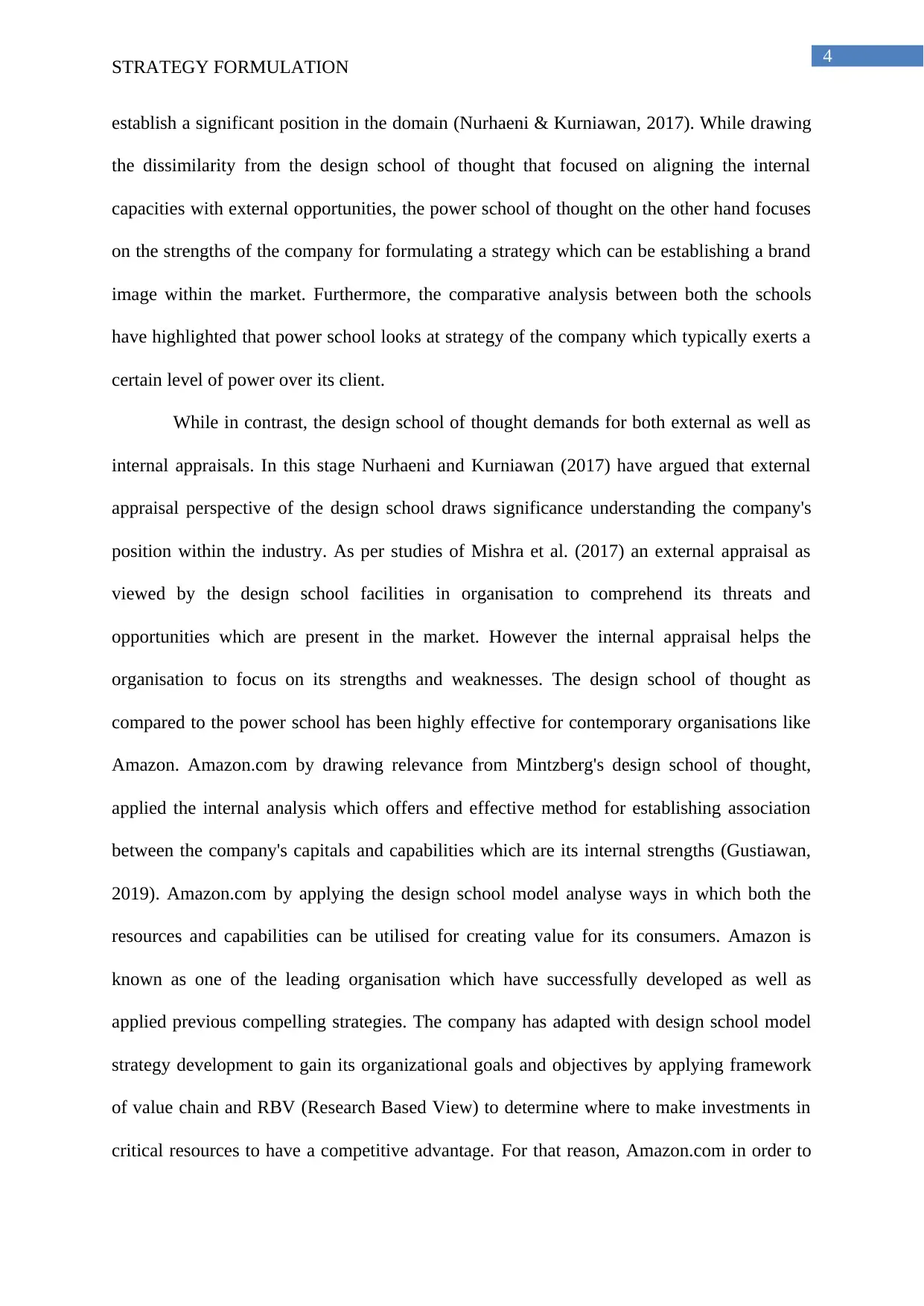
4
STRATEGY FORMULATION
establish a significant position in the domain (Nurhaeni & Kurniawan, 2017). While drawing
the dissimilarity from the design school of thought that focused on aligning the internal
capacities with external opportunities, the power school of thought on the other hand focuses
on the strengths of the company for formulating a strategy which can be establishing a brand
image within the market. Furthermore, the comparative analysis between both the schools
have highlighted that power school looks at strategy of the company which typically exerts a
certain level of power over its client.
While in contrast, the design school of thought demands for both external as well as
internal appraisals. In this stage Nurhaeni and Kurniawan (2017) have argued that external
appraisal perspective of the design school draws significance understanding the company's
position within the industry. As per studies of Mishra et al. (2017) an external appraisal as
viewed by the design school facilities in organisation to comprehend its threats and
opportunities which are present in the market. However the internal appraisal helps the
organisation to focus on its strengths and weaknesses. The design school of thought as
compared to the power school has been highly effective for contemporary organisations like
Amazon. Amazon.com by drawing relevance from Mintzberg's design school of thought,
applied the internal analysis which offers and effective method for establishing association
between the company's capitals and capabilities which are its internal strengths (Gustiawan,
2019). Amazon.com by applying the design school model analyse ways in which both the
resources and capabilities can be utilised for creating value for its consumers. Amazon is
known as one of the leading organisation which have successfully developed as well as
applied previous compelling strategies. The company has adapted with design school model
strategy development to gain its organizational goals and objectives by applying framework
of value chain and RBV (Research Based View) to determine where to make investments in
critical resources to have a competitive advantage. For that reason, Amazon.com in order to
STRATEGY FORMULATION
establish a significant position in the domain (Nurhaeni & Kurniawan, 2017). While drawing
the dissimilarity from the design school of thought that focused on aligning the internal
capacities with external opportunities, the power school of thought on the other hand focuses
on the strengths of the company for formulating a strategy which can be establishing a brand
image within the market. Furthermore, the comparative analysis between both the schools
have highlighted that power school looks at strategy of the company which typically exerts a
certain level of power over its client.
While in contrast, the design school of thought demands for both external as well as
internal appraisals. In this stage Nurhaeni and Kurniawan (2017) have argued that external
appraisal perspective of the design school draws significance understanding the company's
position within the industry. As per studies of Mishra et al. (2017) an external appraisal as
viewed by the design school facilities in organisation to comprehend its threats and
opportunities which are present in the market. However the internal appraisal helps the
organisation to focus on its strengths and weaknesses. The design school of thought as
compared to the power school has been highly effective for contemporary organisations like
Amazon. Amazon.com by drawing relevance from Mintzberg's design school of thought,
applied the internal analysis which offers and effective method for establishing association
between the company's capitals and capabilities which are its internal strengths (Gustiawan,
2019). Amazon.com by applying the design school model analyse ways in which both the
resources and capabilities can be utilised for creating value for its consumers. Amazon is
known as one of the leading organisation which have successfully developed as well as
applied previous compelling strategies. The company has adapted with design school model
strategy development to gain its organizational goals and objectives by applying framework
of value chain and RBV (Research Based View) to determine where to make investments in
critical resources to have a competitive advantage. For that reason, Amazon.com in order to
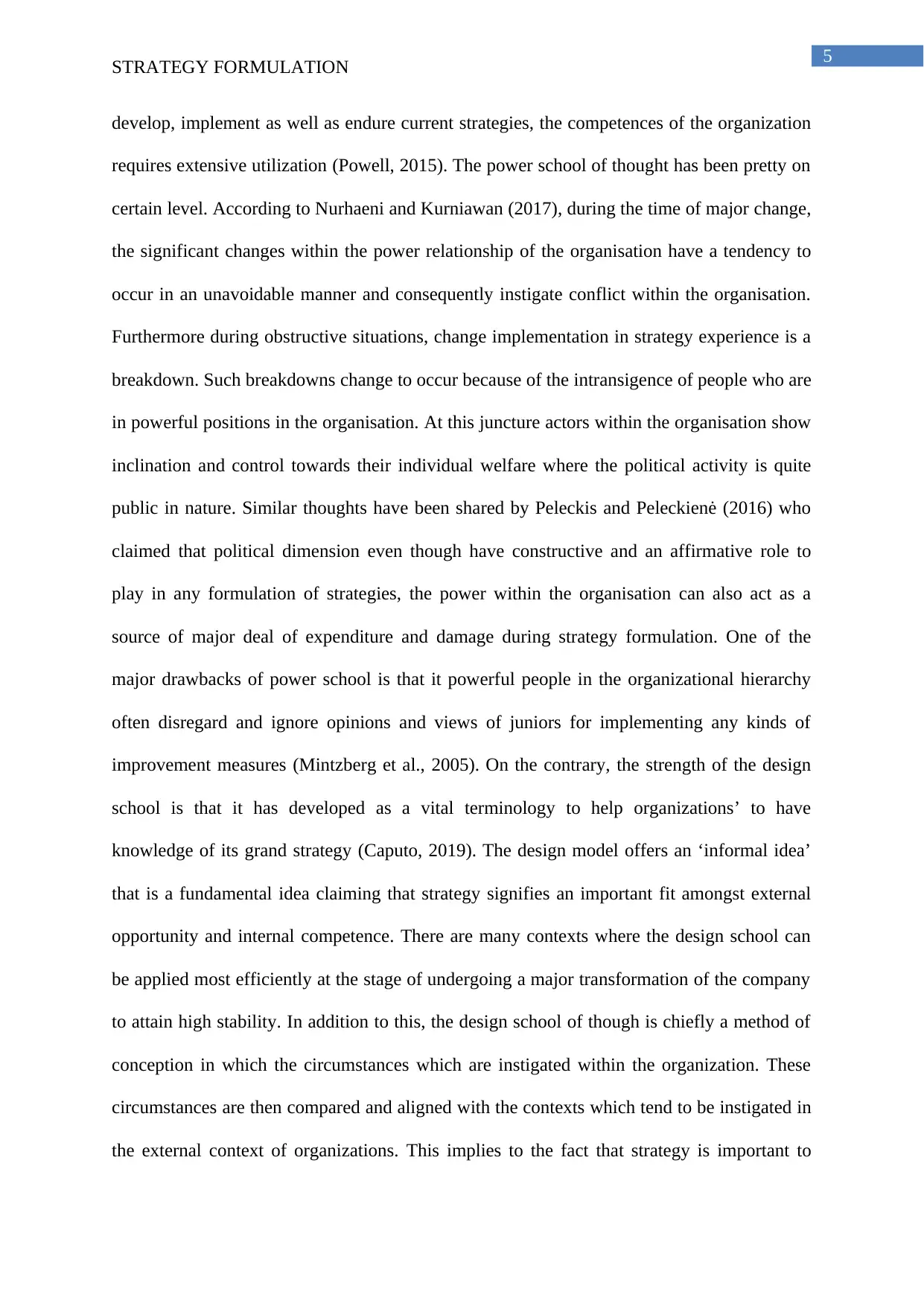
5
STRATEGY FORMULATION
develop, implement as well as endure current strategies, the competences of the organization
requires extensive utilization (Powell, 2015). The power school of thought has been pretty on
certain level. According to Nurhaeni and Kurniawan (2017), during the time of major change,
the significant changes within the power relationship of the organisation have a tendency to
occur in an unavoidable manner and consequently instigate conflict within the organisation.
Furthermore during obstructive situations, change implementation in strategy experience is a
breakdown. Such breakdowns change to occur because of the intransigence of people who are
in powerful positions in the organisation. At this juncture actors within the organisation show
inclination and control towards their individual welfare where the political activity is quite
public in nature. Similar thoughts have been shared by Peleckis and Peleckienė (2016) who
claimed that political dimension even though have constructive and an affirmative role to
play in any formulation of strategies, the power within the organisation can also act as a
source of major deal of expenditure and damage during strategy formulation. One of the
major drawbacks of power school is that it powerful people in the organizational hierarchy
often disregard and ignore opinions and views of juniors for implementing any kinds of
improvement measures (Mintzberg et al., 2005). On the contrary, the strength of the design
school is that it has developed as a vital terminology to help organizations’ to have
knowledge of its grand strategy (Caputo, 2019). The design model offers an ‘informal idea’
that is a fundamental idea claiming that strategy signifies an important fit amongst external
opportunity and internal competence. There are many contexts where the design school can
be applied most efficiently at the stage of undergoing a major transformation of the company
to attain high stability. In addition to this, the design school of though is chiefly a method of
conception in which the circumstances which are instigated within the organization. These
circumstances are then compared and aligned with the contexts which tend to be instigated in
the external context of organizations. This implies to the fact that strategy is important to
STRATEGY FORMULATION
develop, implement as well as endure current strategies, the competences of the organization
requires extensive utilization (Powell, 2015). The power school of thought has been pretty on
certain level. According to Nurhaeni and Kurniawan (2017), during the time of major change,
the significant changes within the power relationship of the organisation have a tendency to
occur in an unavoidable manner and consequently instigate conflict within the organisation.
Furthermore during obstructive situations, change implementation in strategy experience is a
breakdown. Such breakdowns change to occur because of the intransigence of people who are
in powerful positions in the organisation. At this juncture actors within the organisation show
inclination and control towards their individual welfare where the political activity is quite
public in nature. Similar thoughts have been shared by Peleckis and Peleckienė (2016) who
claimed that political dimension even though have constructive and an affirmative role to
play in any formulation of strategies, the power within the organisation can also act as a
source of major deal of expenditure and damage during strategy formulation. One of the
major drawbacks of power school is that it powerful people in the organizational hierarchy
often disregard and ignore opinions and views of juniors for implementing any kinds of
improvement measures (Mintzberg et al., 2005). On the contrary, the strength of the design
school is that it has developed as a vital terminology to help organizations’ to have
knowledge of its grand strategy (Caputo, 2019). The design model offers an ‘informal idea’
that is a fundamental idea claiming that strategy signifies an important fit amongst external
opportunity and internal competence. There are many contexts where the design school can
be applied most efficiently at the stage of undergoing a major transformation of the company
to attain high stability. In addition to this, the design school of though is chiefly a method of
conception in which the circumstances which are instigated within the organization. These
circumstances are then compared and aligned with the contexts which tend to be instigated in
the external context of organizations. This implies to the fact that strategy is important to
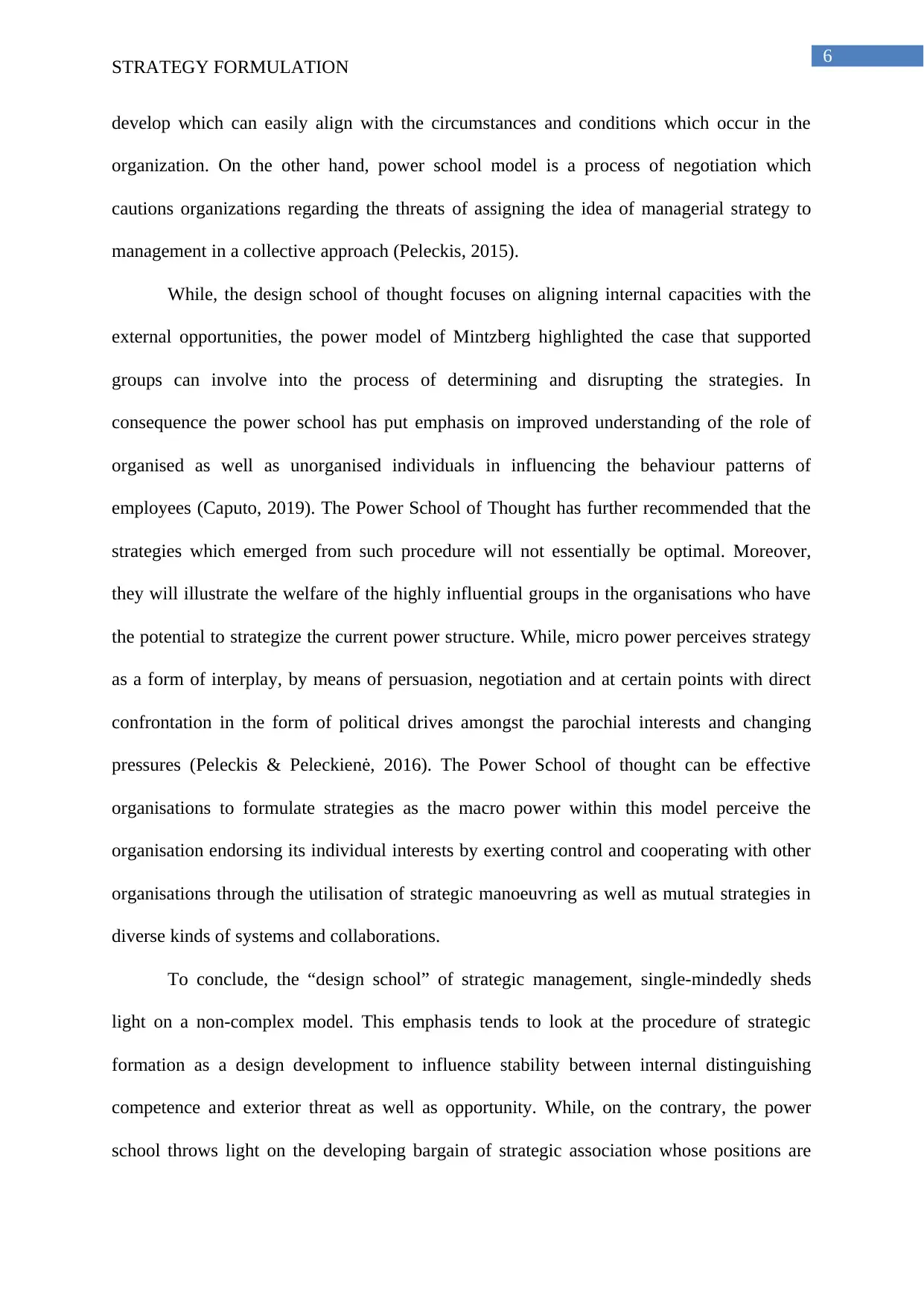
6
STRATEGY FORMULATION
develop which can easily align with the circumstances and conditions which occur in the
organization. On the other hand, power school model is a process of negotiation which
cautions organizations regarding the threats of assigning the idea of managerial strategy to
management in a collective approach (Peleckis, 2015).
While, the design school of thought focuses on aligning internal capacities with the
external opportunities, the power model of Mintzberg highlighted the case that supported
groups can involve into the process of determining and disrupting the strategies. In
consequence the power school has put emphasis on improved understanding of the role of
organised as well as unorganised individuals in influencing the behaviour patterns of
employees (Caputo, 2019). The Power School of Thought has further recommended that the
strategies which emerged from such procedure will not essentially be optimal. Moreover,
they will illustrate the welfare of the highly influential groups in the organisations who have
the potential to strategize the current power structure. While, micro power perceives strategy
as a form of interplay, by means of persuasion, negotiation and at certain points with direct
confrontation in the form of political drives amongst the parochial interests and changing
pressures (Peleckis & Peleckienė, 2016). The Power School of thought can be effective
organisations to formulate strategies as the macro power within this model perceive the
organisation endorsing its individual interests by exerting control and cooperating with other
organisations through the utilisation of strategic manoeuvring as well as mutual strategies in
diverse kinds of systems and collaborations.
To conclude, the “design school” of strategic management, single-mindedly sheds
light on a non-complex model. This emphasis tends to look at the procedure of strategic
formation as a design development to influence stability between internal distinguishing
competence and exterior threat as well as opportunity. While, on the contrary, the power
school throws light on the developing bargain of strategic association whose positions are
STRATEGY FORMULATION
develop which can easily align with the circumstances and conditions which occur in the
organization. On the other hand, power school model is a process of negotiation which
cautions organizations regarding the threats of assigning the idea of managerial strategy to
management in a collective approach (Peleckis, 2015).
While, the design school of thought focuses on aligning internal capacities with the
external opportunities, the power model of Mintzberg highlighted the case that supported
groups can involve into the process of determining and disrupting the strategies. In
consequence the power school has put emphasis on improved understanding of the role of
organised as well as unorganised individuals in influencing the behaviour patterns of
employees (Caputo, 2019). The Power School of Thought has further recommended that the
strategies which emerged from such procedure will not essentially be optimal. Moreover,
they will illustrate the welfare of the highly influential groups in the organisations who have
the potential to strategize the current power structure. While, micro power perceives strategy
as a form of interplay, by means of persuasion, negotiation and at certain points with direct
confrontation in the form of political drives amongst the parochial interests and changing
pressures (Peleckis & Peleckienė, 2016). The Power School of thought can be effective
organisations to formulate strategies as the macro power within this model perceive the
organisation endorsing its individual interests by exerting control and cooperating with other
organisations through the utilisation of strategic manoeuvring as well as mutual strategies in
diverse kinds of systems and collaborations.
To conclude, the “design school” of strategic management, single-mindedly sheds
light on a non-complex model. This emphasis tends to look at the procedure of strategic
formation as a design development to influence stability between internal distinguishing
competence and exterior threat as well as opportunity. While, on the contrary, the power
school throws light on the developing bargain of strategic association whose positions are
Paraphrase This Document
Need a fresh take? Get an instant paraphrase of this document with our AI Paraphraser
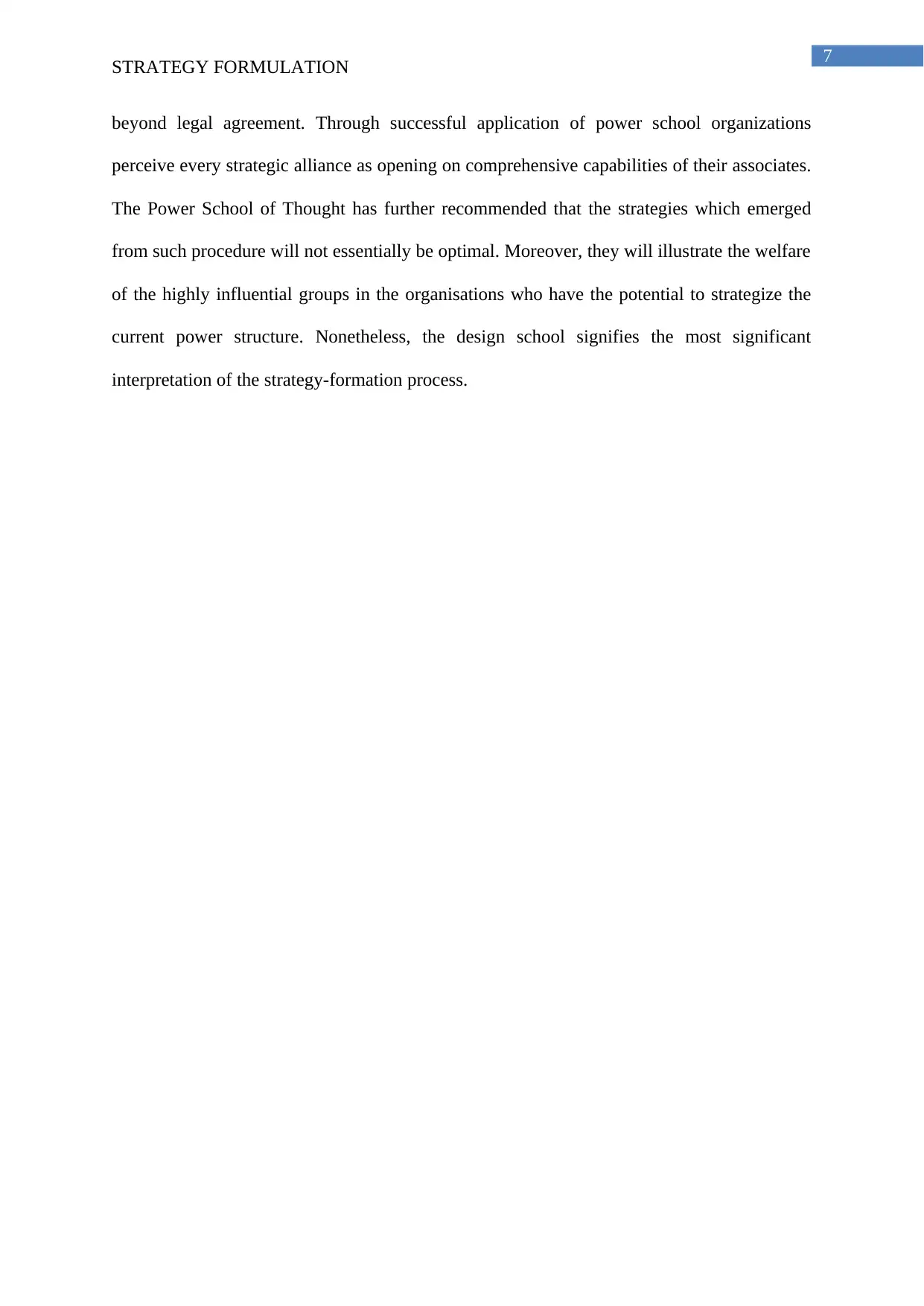
7
STRATEGY FORMULATION
beyond legal agreement. Through successful application of power school organizations
perceive every strategic alliance as opening on comprehensive capabilities of their associates.
The Power School of Thought has further recommended that the strategies which emerged
from such procedure will not essentially be optimal. Moreover, they will illustrate the welfare
of the highly influential groups in the organisations who have the potential to strategize the
current power structure. Nonetheless, the design school signifies the most significant
interpretation of the strategy-formation process.
STRATEGY FORMULATION
beyond legal agreement. Through successful application of power school organizations
perceive every strategic alliance as opening on comprehensive capabilities of their associates.
The Power School of Thought has further recommended that the strategies which emerged
from such procedure will not essentially be optimal. Moreover, they will illustrate the welfare
of the highly influential groups in the organisations who have the potential to strategize the
current power structure. Nonetheless, the design school signifies the most significant
interpretation of the strategy-formation process.
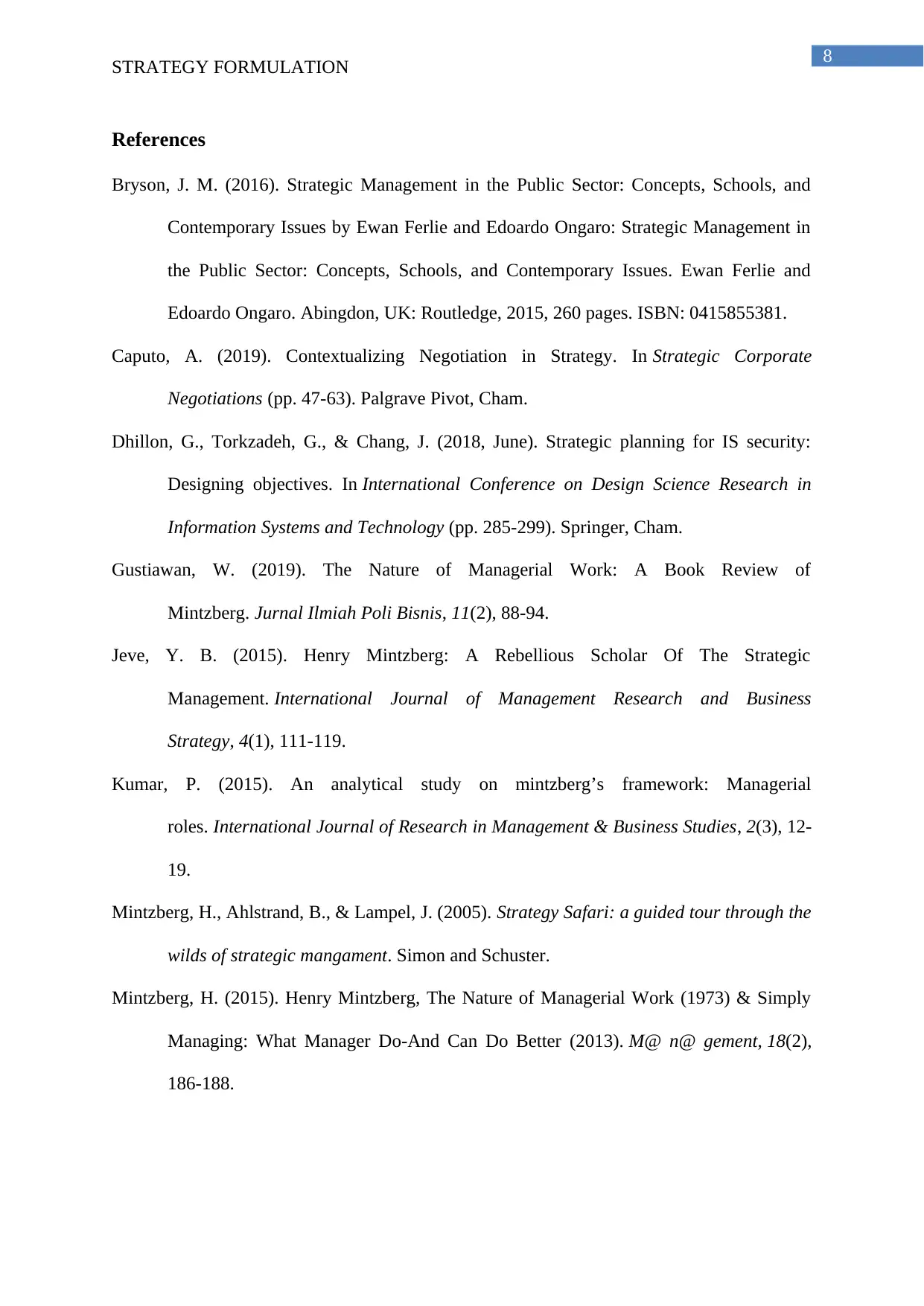
8
STRATEGY FORMULATION
References
Bryson, J. M. (2016). Strategic Management in the Public Sector: Concepts, Schools, and
Contemporary Issues by Ewan Ferlie and Edoardo Ongaro: Strategic Management in
the Public Sector: Concepts, Schools, and Contemporary Issues. Ewan Ferlie and
Edoardo Ongaro. Abingdon, UK: Routledge, 2015, 260 pages. ISBN: 0415855381.
Caputo, A. (2019). Contextualizing Negotiation in Strategy. In Strategic Corporate
Negotiations (pp. 47-63). Palgrave Pivot, Cham.
Dhillon, G., Torkzadeh, G., & Chang, J. (2018, June). Strategic planning for IS security:
Designing objectives. In International Conference on Design Science Research in
Information Systems and Technology (pp. 285-299). Springer, Cham.
Gustiawan, W. (2019). The Nature of Managerial Work: A Book Review of
Mintzberg. Jurnal Ilmiah Poli Bisnis, 11(2), 88-94.
Jeve, Y. B. (2015). Henry Mintzberg: A Rebellious Scholar Of The Strategic
Management. International Journal of Management Research and Business
Strategy, 4(1), 111-119.
Kumar, P. (2015). An analytical study on mintzberg’s framework: Managerial
roles. International Journal of Research in Management & Business Studies, 2(3), 12-
19.
Mintzberg, H., Ahlstrand, B., & Lampel, J. (2005). Strategy Safari: a guided tour through the
wilds of strategic mangament. Simon and Schuster.
Mintzberg, H. (2015). Henry Mintzberg, The Nature of Managerial Work (1973) & Simply
Managing: What Manager Do-And Can Do Better (2013). M@ n@ gement, 18(2),
186-188.
STRATEGY FORMULATION
References
Bryson, J. M. (2016). Strategic Management in the Public Sector: Concepts, Schools, and
Contemporary Issues by Ewan Ferlie and Edoardo Ongaro: Strategic Management in
the Public Sector: Concepts, Schools, and Contemporary Issues. Ewan Ferlie and
Edoardo Ongaro. Abingdon, UK: Routledge, 2015, 260 pages. ISBN: 0415855381.
Caputo, A. (2019). Contextualizing Negotiation in Strategy. In Strategic Corporate
Negotiations (pp. 47-63). Palgrave Pivot, Cham.
Dhillon, G., Torkzadeh, G., & Chang, J. (2018, June). Strategic planning for IS security:
Designing objectives. In International Conference on Design Science Research in
Information Systems and Technology (pp. 285-299). Springer, Cham.
Gustiawan, W. (2019). The Nature of Managerial Work: A Book Review of
Mintzberg. Jurnal Ilmiah Poli Bisnis, 11(2), 88-94.
Jeve, Y. B. (2015). Henry Mintzberg: A Rebellious Scholar Of The Strategic
Management. International Journal of Management Research and Business
Strategy, 4(1), 111-119.
Kumar, P. (2015). An analytical study on mintzberg’s framework: Managerial
roles. International Journal of Research in Management & Business Studies, 2(3), 12-
19.
Mintzberg, H., Ahlstrand, B., & Lampel, J. (2005). Strategy Safari: a guided tour through the
wilds of strategic mangament. Simon and Schuster.
Mintzberg, H. (2015). Henry Mintzberg, The Nature of Managerial Work (1973) & Simply
Managing: What Manager Do-And Can Do Better (2013). M@ n@ gement, 18(2),
186-188.
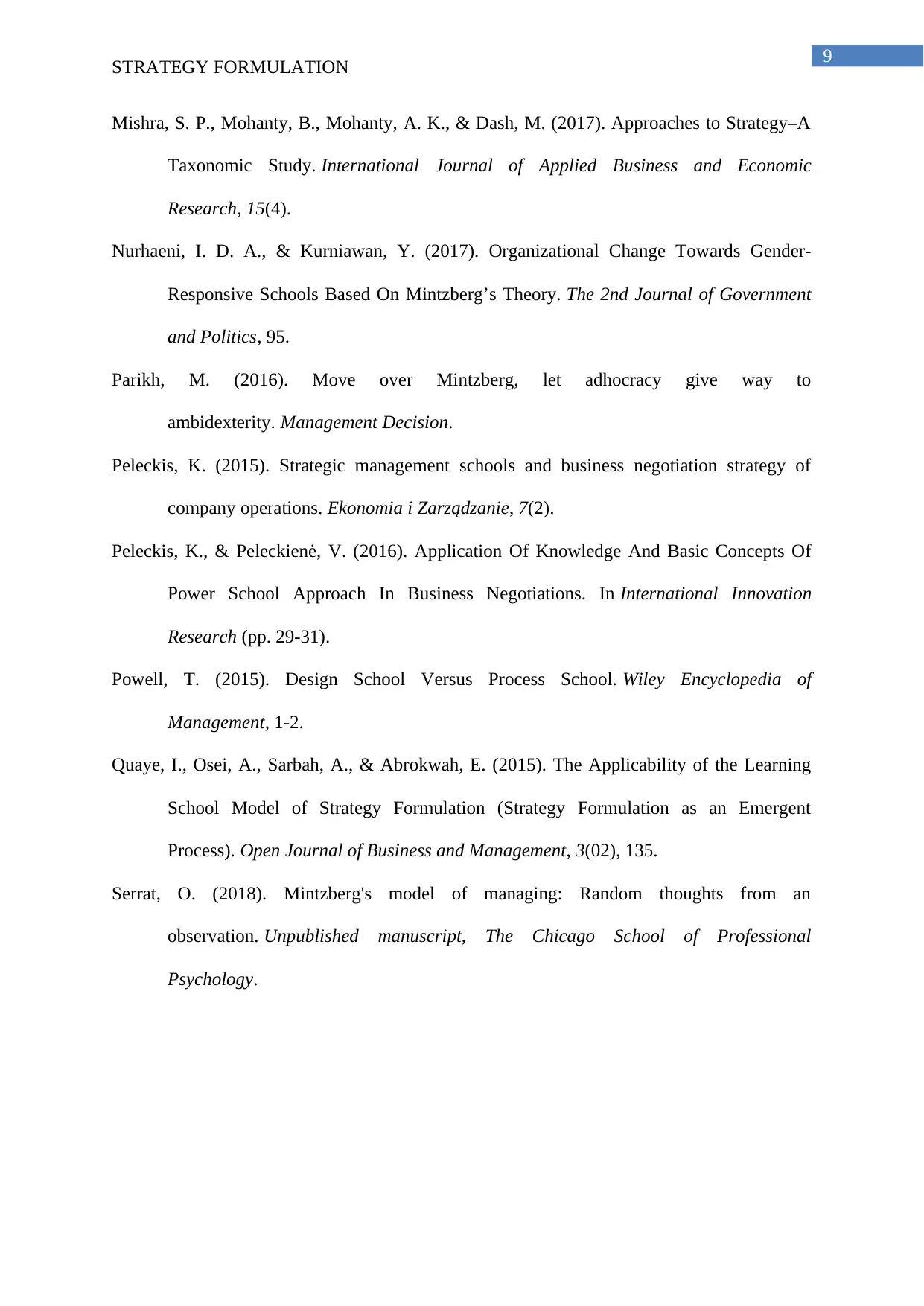
9
STRATEGY FORMULATION
Mishra, S. P., Mohanty, B., Mohanty, A. K., & Dash, M. (2017). Approaches to Strategy–A
Taxonomic Study. International Journal of Applied Business and Economic
Research, 15(4).
Nurhaeni, I. D. A., & Kurniawan, Y. (2017). Organizational Change Towards Gender-
Responsive Schools Based On Mintzberg’s Theory. The 2nd Journal of Government
and Politics, 95.
Parikh, M. (2016). Move over Mintzberg, let adhocracy give way to
ambidexterity. Management Decision.
Peleckis, K. (2015). Strategic management schools and business negotiation strategy of
company operations. Ekonomia i Zarządzanie, 7(2).
Peleckis, K., & Peleckienė, V. (2016). Application Of Knowledge And Basic Concepts Of
Power School Approach In Business Negotiations. In International Innovation
Research (pp. 29-31).
Powell, T. (2015). Design School Versus Process School. Wiley Encyclopedia of
Management, 1-2.
Quaye, I., Osei, A., Sarbah, A., & Abrokwah, E. (2015). The Applicability of the Learning
School Model of Strategy Formulation (Strategy Formulation as an Emergent
Process). Open Journal of Business and Management, 3(02), 135.
Serrat, O. (2018). Mintzberg's model of managing: Random thoughts from an
observation. Unpublished manuscript, The Chicago School of Professional
Psychology.
STRATEGY FORMULATION
Mishra, S. P., Mohanty, B., Mohanty, A. K., & Dash, M. (2017). Approaches to Strategy–A
Taxonomic Study. International Journal of Applied Business and Economic
Research, 15(4).
Nurhaeni, I. D. A., & Kurniawan, Y. (2017). Organizational Change Towards Gender-
Responsive Schools Based On Mintzberg’s Theory. The 2nd Journal of Government
and Politics, 95.
Parikh, M. (2016). Move over Mintzberg, let adhocracy give way to
ambidexterity. Management Decision.
Peleckis, K. (2015). Strategic management schools and business negotiation strategy of
company operations. Ekonomia i Zarządzanie, 7(2).
Peleckis, K., & Peleckienė, V. (2016). Application Of Knowledge And Basic Concepts Of
Power School Approach In Business Negotiations. In International Innovation
Research (pp. 29-31).
Powell, T. (2015). Design School Versus Process School. Wiley Encyclopedia of
Management, 1-2.
Quaye, I., Osei, A., Sarbah, A., & Abrokwah, E. (2015). The Applicability of the Learning
School Model of Strategy Formulation (Strategy Formulation as an Emergent
Process). Open Journal of Business and Management, 3(02), 135.
Serrat, O. (2018). Mintzberg's model of managing: Random thoughts from an
observation. Unpublished manuscript, The Chicago School of Professional
Psychology.
1 out of 10
Related Documents
Your All-in-One AI-Powered Toolkit for Academic Success.
+13062052269
info@desklib.com
Available 24*7 on WhatsApp / Email
![[object Object]](/_next/static/media/star-bottom.7253800d.svg)
Unlock your academic potential
© 2024 | Zucol Services PVT LTD | All rights reserved.





